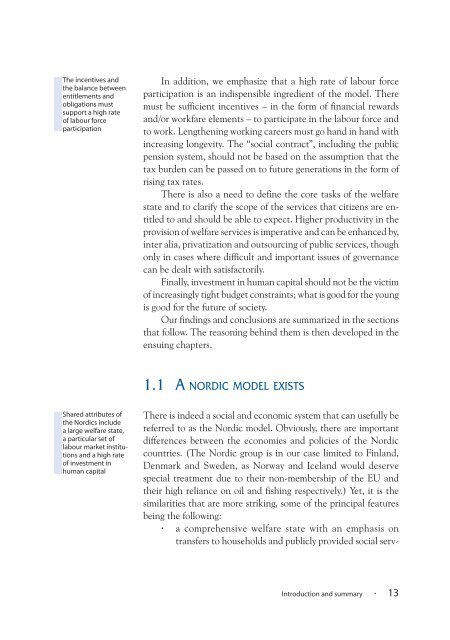The Nordic Model - Embracing globalization and sharing risks
The Nordic Model - Embracing globalization and sharing risks
The Nordic Model - Embracing globalization and sharing risks
You also want an ePaper? Increase the reach of your titles
YUMPU automatically turns print PDFs into web optimized ePapers that Google loves.
<strong>The</strong> incentives <strong>and</strong><br />
the balance between<br />
entitlements <strong>and</strong><br />
obligations must<br />
support a high rate<br />
of labour force<br />
participation<br />
In addition, we emphasize that a high rate of labour force<br />
participation is an indispensible ingredient of the model. <strong>The</strong>re<br />
must be sufficient incentives – in the form of financial rewards<br />
<strong>and</strong>/or workfare elements – to participate in the labour force <strong>and</strong><br />
to work. Lengthening working careers must go h<strong>and</strong> in h<strong>and</strong> with<br />
increasing longevity. <strong>The</strong> “social contract”, including the public<br />
pension system, should not be based on the assumption that the<br />
tax burden can be passed on to future generations in the form of<br />
rising tax rates.<br />
<strong>The</strong>re is also a need to define the core tasks of the welfare<br />
state <strong>and</strong> to clarify the scope of the services that citizens are entitled<br />
to <strong>and</strong> should be able to expect. Higher productivity in the<br />
provision of welfare services is imperative <strong>and</strong> can be enhanced by,<br />
inter alia, privatization <strong>and</strong> outsourcing of public services, though<br />
only in cases where difficult <strong>and</strong> important issues of governance<br />
can be dealt with satisfactorily.<br />
Finally, investment in human capital should not be the victim<br />
of increasingly tight budget constraints; what is good for the young<br />
is good for the future of society.<br />
Our findings <strong>and</strong> conclusions are summarized in the sections<br />
that follow. <strong>The</strong> reasoning behind them is then developed in the<br />
ensuing chapters.<br />
1.1 A NORDIC MODEL EXISTS<br />
Shared attributes of<br />
the <strong>Nordic</strong>s include<br />
a large welfare state,<br />
a particular set of<br />
labour market institutions<br />
<strong>and</strong> a high rate<br />
of investment in<br />
human capital<br />
<strong>The</strong>re is indeed a social <strong>and</strong> economic system that can usefully be<br />
referred to as the <strong>Nordic</strong> model. Obviously, there are important<br />
differences between the economies <strong>and</strong> policies of the <strong>Nordic</strong><br />
countries. (<strong>The</strong> <strong>Nordic</strong> group is in our case limited to Finl<strong>and</strong>,<br />
Denmark <strong>and</strong> Sweden, as Norway <strong>and</strong> Icel<strong>and</strong> would deserve<br />
special treatment due to their non-membership of the EU <strong>and</strong><br />
their high reliance on oil <strong>and</strong> fishing respectively.) Yet, it is the<br />
similarities that are more striking, some of the principal features<br />
being the following:<br />
· a comprehensive welfare state with an emphasis on<br />
transfers to households <strong>and</strong> publicly provided social serv-<br />
Introduction <strong>and</strong> summary · 13

















